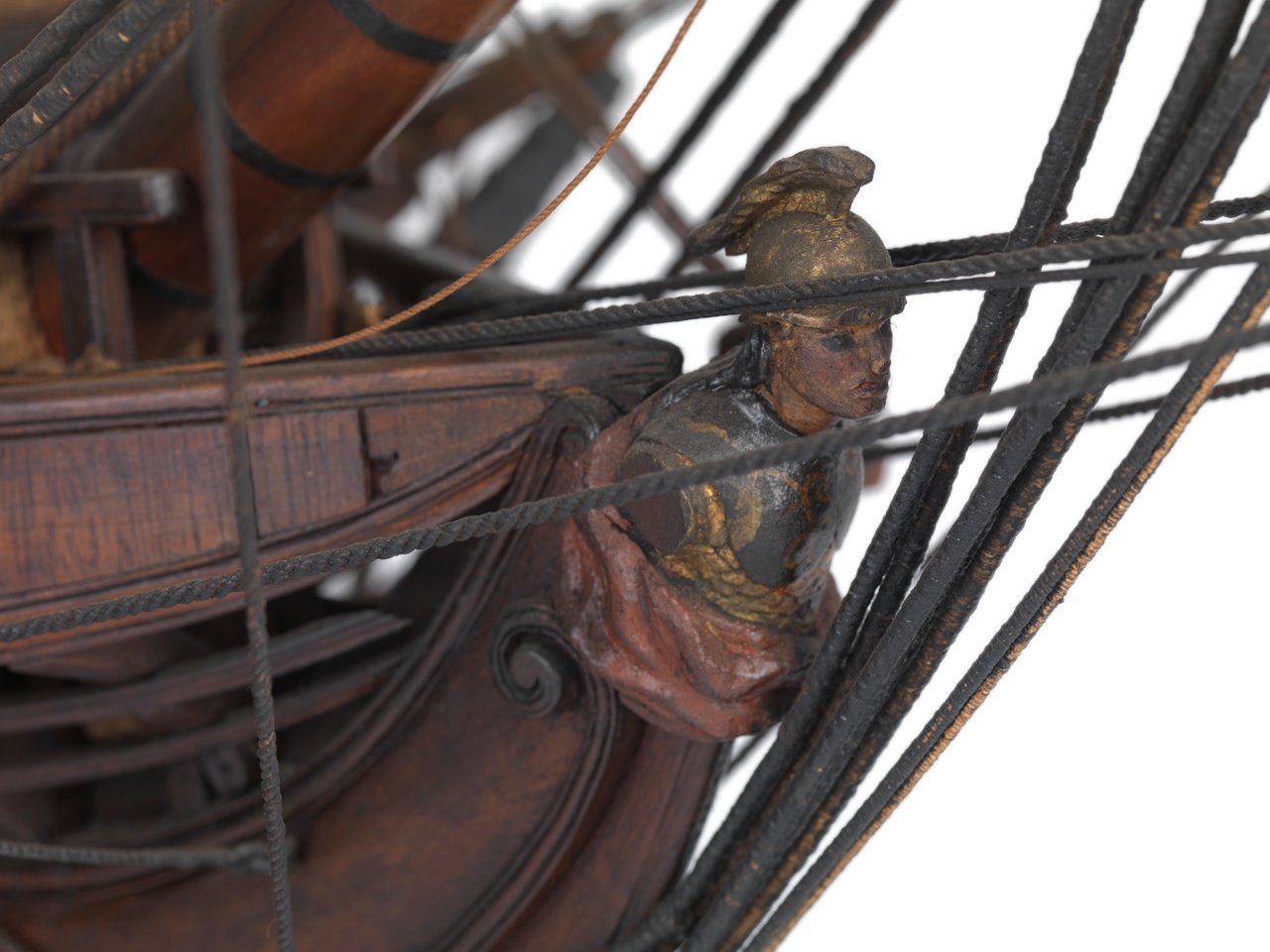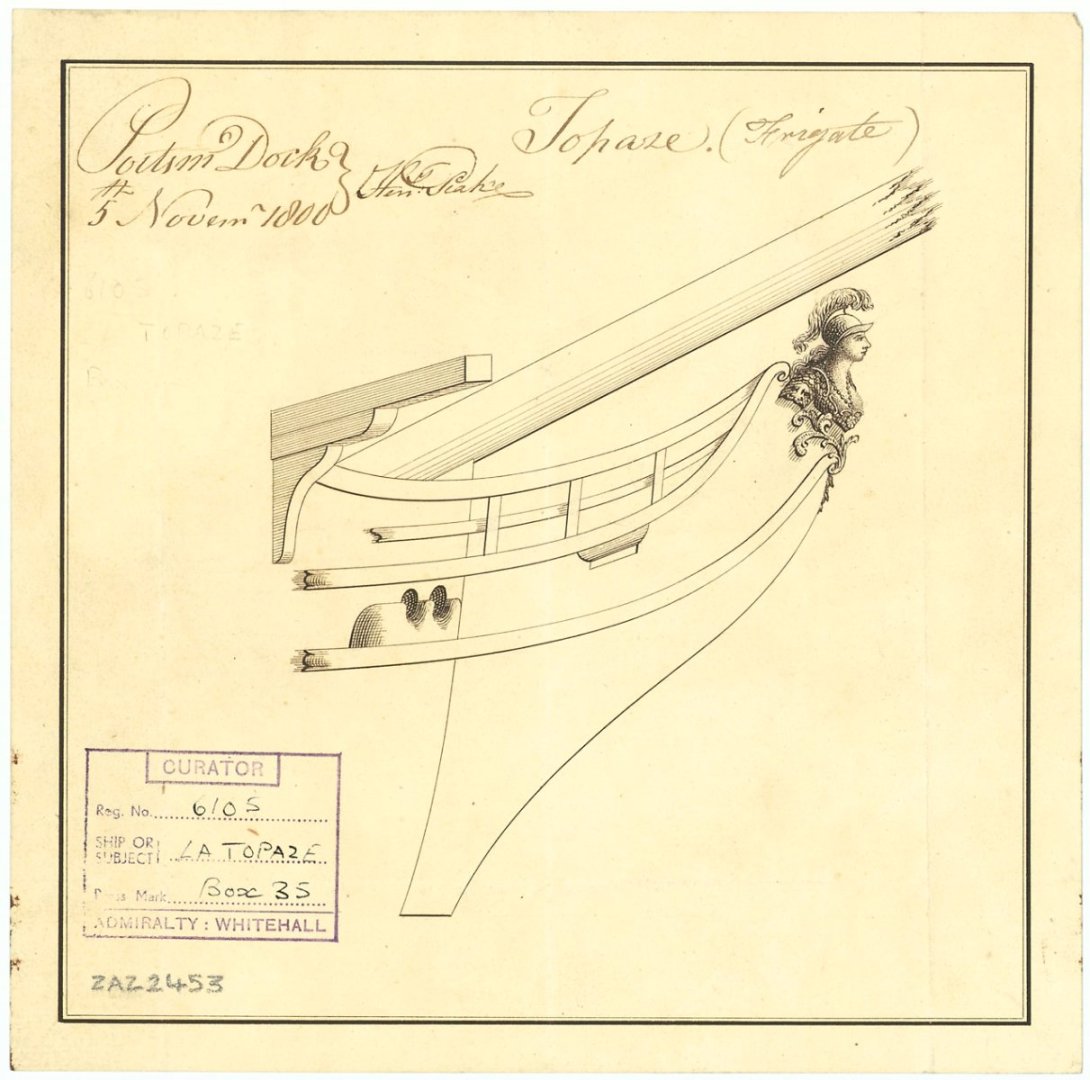-
Posts
8,149 -
Joined
-
Last visited
Content Type
Profiles
Forums
Gallery
Events
Everything posted by allanyed
-
The bust generally only included the chest and head, no appendages. The following are all from the RMG Collections site. The first photo is the bust on a third rate of about 1813 The next is a drawing of a bust of about 1805 The last is a figure head on the model of the Hercules or Thunderer circa 1860 Allan
-
Conversely you can get sheet stock, the thickness of which is the same as the widest dimension of the plank itself and slit off planks with a small table saw such as a Byrnes if you have one. If not, I would do as Walrusguy suggests and then slit planks with a scalpel as they are no doubt pretty thin planks. Crown Timber used to be a great go-to for sheets of these species and many others before they closed their doors. I am anxious to hear about other sources for pre-thicknessed sheets. Allan
-
The boat kits from Syren are perhaps the very best available. In any case do yourself a favor and check the logs here at MSW before buying any other boat kit as the majority are lacking in many aspects. There is always scratch building 😀 For small boats, power tools are a nicety but not necessary. Allan
-
I worked in a small village, San Casciano (VP) but usually stayed in hotels in Firenze as the clients that traveled with me would usually bring a wife or girlfriend (never both on the same trip) and they would want to be in Florence while we went to work. I also spent a lot of time at a company called Universal Pack in Cattolica not too far north of you. Some of the best seafood in the world is in your area!! I just started to watch your whale boat videos and have learned something today, thank you for posting your methods. You have an expert ship modeler across the country from you not far from Pisa that I plan to meet for lunch with our wives in September. Check out his build log here at MSW. Ciao Carlo
-
The first videos showing planking on the bulkheads, then framing, the outer planking are new for me and I see this being a great way to go for very small scale vessels that would have both inside and outside planking. Do you complete the outer planking before removing the bulkhead structure or after? I do not see you actually removing the bulkheads in the video. I like how you use tape on the bulkheads so any excess glue does not stick the inner planking to these parts. Thanks for sharing Allan
- 4 replies
-
- New Bedford Whaleboat
- Finished
-
(and 1 more)
Tagged with:
-
Buongiorno and welcome to MSW Carlo. It is nice to see you promoting our hobby and showing folks your own methods such as the planking in your video. Where in Italy are you located? I had the good fortune to work in Italy making numerous trips each year for over 30 years to Toscana and Lombardia. No longer being able to visit your country as often is one thing I do not like about retiring. Ciao Allan
-
Thanks Masa, I would like to get some and check it out but I have my doubts. "A good thread count for microfiber sheets is anywhere between 200 and 800. Microfiber is known for its softness and sheets from this material tend to get softer every time they're washed. If you see thread counts of 800 or more, the manufacturer likely inflated the thread count. Some manufacturers twist their yarns for weaving, essentially doubling or more what the thread count would be in reality. Thanks again Allan
-
Hi Dziadeczek, What is the thread count of your material? Looking on line, muslin is shown to normally be between 150 and 180 so would be far out of scale for 1:24 and smaller. Canvas has a TC of about 50 per inch so to be close to scale at 1:48 it would have to have a TC of over 2000 or conversely, using180 count material like muslin would have the equivalent of threads that are 1/4" in diameter. Same can be said for stitching. I realize it comes down to how much scale accuracy each builder wants. Allan
-
Welcome to MSW. You made a very wise decision in your first projects. Allan
-

Running Rigging _ Running in Circles....
allanyed replied to USNCHief's topic in Masting, rigging and sails
Hi Chief, The slot and cover board are far easier to work with rather than any kind of hole. You don't have to feed the deadeye strop through the hole, merely slip it in the slot. Once they are in place, the molding board keeps them in place. Easy peasy compared to forcing them though the holes. Wonder why it took those folks until 1771 to figure this out, especially when it came to replacing worn or damaged deadeyes and links. Allan -
Thanks Daniel, The boat stowage on Betts' drawing has similarities to the contemporary drawing at RMG of Erebus and Terror ZAZ5673 which you probably already know is on the Wiki Commons site in high resolution along with all the other RMG drawings of Terror and Erebus. I realize Matts' drawing is not exactly the same and you had mentioned previously his was made by cleaning up and amalgamating the data from various original draughts, none of which depict the ship exactly as she was at the time of the last expedition. Allan
-

Making a Silk-fabric(?) Sail
allanyed replied to modeller_masa's topic in Masting, rigging and sails
Modeler Masa, Thank you for the above, it is very well studied and thought out, but I think the name of the subject might be misleading. The trials you did seem to use cloth, not silkspan, which is tissue paper made from wood fiber and acts differently than cloth. Allan -
Lovely build!! The belaying pins look great compared to the majority of other kit makers' pins. Are they supplied with the kit? Do you know what material is used for the rigging line? Thanks for all the photos and sharing with us, it is fun to follow your build. Allan
- 476 replies
-
- sphinx
- vanguard models
-
(and 1 more)
Tagged with:
-
Welcome to the fray Rich Great to see someone start off with kits that will help learn as you go versus starting with a ship of the line. In addition to tools, if the bug really bit you hard, get ready to hit the bank account for books as there are a lot of great ones for our hobby. Allan
-
I agree. Where parts in the kit have been thrown out and replaced the beauty of the model goes up exponentially. Quick question/observation.... The boats are upside down but those on Clearway's are not. I don't recall seeing them upside down on any ship, but was this an exception because of her role or was there some other reason? Handling them from the upside down position would be a nightmare, especially if it was an emergency situation. Hopefully there is some contemporary information on the whys on this one. Allan
-
I try not to use MM as their prices are high, but sometimes they are the only game in town. They used to carry blackend nails as well, so check to see. If you can only find brass soak them in a pickling solution then rinse thoroughly and blacken with a blackening agent. Whether you do it or get them already blackened, tapping them home will often expose the brass head again. https://www.micromark.com/Mini-Nails-3-8-Inch-Long-x-020-Inch-Dia-Pkg-of-100?gclid=Cj0KCQjw5ZSWBhCVARIsALERCvy2_kxKGzI89NcROjw8aisnyAtC48WdTr7heEeu782hMF3pb5KURVoaAsbdEALw_wcB I don't know the application you have in mind, but if you can, may you can go with copper wire which you can get in 24 or 26 gauge to be very close to 0.02" Once in place the end can be blackened with liver of sulfur. Allan
-

Question about Sails on the Yacht "Westward"
allanyed replied to Ferrus Manus's topic in Masting, rigging and sails
Hi Ferrus I did a little digging and come up with nothing on what that sail is. As to adjusting the spinnaker, genoa, or gennaker, on a reach the following may help you. https://www.sail-world.com/news/236121/Beginners-guide-to-using-a-Spinnaker Allan -

Running Rigging _ Running in Circles....
allanyed replied to USNCHief's topic in Masting, rigging and sails
Hi Chief What ship/year is your model? The reason I ask is that, depending on era, the openings in the channels were holes as you show them only up until 1771 but then slotted with an outboard edge cover board after that, at least in the RN (Goodwin The Construction and Fitting of the English Man of War, page 187). I believe that this was the case for American ships as well by the time of Baltimore Clippers in the 19th century. Hopefully a member will have additional contemporary based information. Allan -

Running Rigging _ Running in Circles....
allanyed replied to USNCHief's topic in Masting, rigging and sails
Chief, The above is all too true. I wish you or someone would find and share a free detailed rigging source that covers hundreds of years and a full range of ship sizes. In the meantime you will need to invest in a good rigging book, but alas, there is only one that I know of, Lees' Masting and Rigging It is based on English ships. Marquardt is another great choice but I think it only covers the 18th century. Anderson is great as well, but is limited to the Days of the Spritsail Topmast. David Antscherl's volume IV of TFFM model is another that you should consider. Some folks like Petersson's book but it is based on a single contemporary model so very limited. Allan -
Welcome aboard Chris! You certainly are in the middle of the aerospace industry from Vashon to Boeing. From high flying metal to slow moving wood should be a fun change. Per all the posts, start slow, but be sure to stay with quality kits. Not all kit makers are created equal. As a true beginner what may make the most sense is to go with the three vessel series that has incremental challenges from Model Shipways that was designed by David Antscherl. Look at the build logs on these as well as others that you may have a hankering to build and be sure to ask for advice on any specific kit BEFORE you buy it. Allan
-

HMS Euryalus 1803 by rlb - 1:48 scale
allanyed replied to rlb's topic in - Build logs for subjects built 1801 - 1850
That is the total truth Greg. No matter how many times these are done, they are never easy. Allan- 122 replies
-
- Euryalus
- Plank-on-frame
-
(and 4 more)
Tagged with:
-
Gorgeous hatch assemblies!! It is so nice to see the coamings and gratings done realistically! Allan
About us
Modelshipworld - Advancing Ship Modeling through Research
SSL Secured
Your security is important for us so this Website is SSL-Secured
NRG Mailing Address
Nautical Research Guild
237 South Lincoln Street
Westmont IL, 60559-1917
Model Ship World ® and the MSW logo are Registered Trademarks, and belong to the Nautical Research Guild (United States Patent and Trademark Office: No. 6,929,264 & No. 6,929,274, registered Dec. 20, 2022)
Helpful Links
About the NRG
If you enjoy building ship models that are historically accurate as well as beautiful, then The Nautical Research Guild (NRG) is just right for you.
The Guild is a non-profit educational organization whose mission is to “Advance Ship Modeling Through Research”. We provide support to our members in their efforts to raise the quality of their model ships.
The Nautical Research Guild has published our world-renowned quarterly magazine, The Nautical Research Journal, since 1955. The pages of the Journal are full of articles by accomplished ship modelers who show you how they create those exquisite details on their models, and by maritime historians who show you the correct details to build. The Journal is available in both print and digital editions. Go to the NRG web site (www.thenrg.org) to download a complimentary digital copy of the Journal. The NRG also publishes plan sets, books and compilations of back issues of the Journal and the former Ships in Scale and Model Ship Builder magazines.






